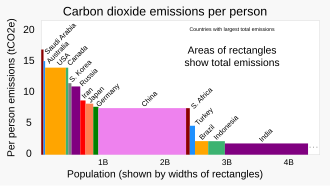Term: Greenhouse gas emissions
**1. Greenhouse Gas Emission Sources and Impact:**
– Greenhouse gases trap heat in the Earth’s atmosphere, leading to global warming.
– Increased levels of carbon dioxide and methane from fossil fuel burning are major contributors to global warming.
– Carbon dioxide is the largest contributor to global greenhouse gas emissions, accounting for 74% in 2016.
– Methane is the second most significant greenhouse gas, contributing 17% to global emissions in the same year.
– Major anthropogenic greenhouse gases include carbon dioxide, nitrous oxide, methane, and fluorinated gases.
– Global efforts are needed to reduce greenhouse gas emissions and combat climate change effectively.
**2. Human Activities and Emission Trends:**
– Industrial activities since 1750 have significantly increased greenhouse gas concentrations.
– Burning fossil fuels, land use changes, livestock, agriculture, and industrial processes are major sources of greenhouse gas emissions.
– Global greenhouse gas emissions continue to rise, with key contributors being fossil fuels and land use changes.
– The energy supply sector accounts for 34% of total emissions, followed by industry (24%), AFOLU sector (22%), transport (15%), and buildings (6%).
– China is the largest emitter, accounting for over a quarter of global emissions.
**3. Measurement and Reporting Methods:**
– Emissions can be measured based on territory or activity principle.
– Emission intensity, calculated as a ratio between greenhouse gas emissions and metrics like GDP or energy use, varies between developed and developing countries.
– Different methods like emission factor-based, mass balance, and monitoring systems are used for emission calculations.
– Cumulative emissions, national accounts balance, and per capita emissions are common measurement tools.
– Climate TRACE is an independent group using satellite data and AI to monitor greenhouse gas emissions.
**4. Greenhouse Gas Types and Impact:**
– Carbon dioxide is the dominant emitted greenhouse gas, mainly from fossil fuels and cement production.
– Methane has a high immediate impact on global warming, with major sources being fossil fuels, livestock, and human waste.
– Nitrous oxide has a high global warming potential, primarily from agriculture and industrial processes.
– F-gases, including HFCs, PFCs, SF6, and NF3, are used in various industries and equipment.
**5. Regional and Historical Emission Trends:**
– Countries with higher GDP per capita tend to have higher emissions per capita.
– China’s per capita emissions are rapidly approaching those of developed countries.
– Developed countries historically emitted a significant portion of industrial CO2 emissions.
– Different regions have contributed varying percentages of cumulative CO2 emissions.
– The UK, despite historical emissions, accounted for only a small percentage of global emissions in 2017.
Greenhouse gas (GHG) emissions from human activities intensify the greenhouse effect. This contributes to climate change. Carbon dioxide (CO2), from burning fossil fuels such as coal, oil, and natural gas, is one of the most important factors in causing climate change. The largest emitters are China followed by the United States. The United States has higher emissions per capita. The main producers fueling the emissions globally are large oil and gas companies. Emissions from human activities have increased atmospheric carbon dioxide by about 50% over pre-industrial levels. The growing levels of emissions have varied, but have been consistent among all greenhouse gases. Emissions in the 2010s averaged 56 billion tons a year, higher than any decade before. Total cumulative emissions from 1870 to 2017 were 425±20 GtC (1558 GtCO2) from fossil fuels and industry, and 180±60 GtC (660 GtCO2) from land use change. Land-use change, such as deforestation, caused about 31% of cumulative emissions over 1870–2017, coal 32%, oil 25%, and gas 10%.

Carbon dioxide (CO2) is the main greenhouse gas resulting from human activities. It accounts for more than half of warming. Methane (CH4) emissions have almost the same short-term impact. Nitrous oxide (N2O) and fluorinated gases (F-gases) play a lesser role in comparison. Emissions of carbon dioxide, methane and nitrous oxide in 2023 were all higher than ever before.
Electricity generation, heat and transport are major emitters; overall energy is responsible for around 73% of emissions. Deforestation and other changes in land use also emit carbon dioxide and methane. The largest source of anthropogenic methane emissions is agriculture, closely followed by gas venting and fugitive emissions from the fossil-fuel industry. The largest agricultural methane source is livestock. Agricultural soils emit nitrous oxide partly due to fertilizers. Similarly, fluorinated gases from refrigerants play an outsized role in total human emissions.
The current CO2-equivalent emission rates averaging 6.6 tonnes per person per year, are well over twice the estimated rate 2.3 tons required to stay within the 2030 Paris Agreement increase of 1.5 °C (2.7 °F) over pre-industrial levels. Annual per capita emissions in the industrialized countries are typically as much as ten times the average in developing countries.
The carbon footprint (or greenhouse gas footprint) serves as an indicator to compare the amount of greenhouse gases emitted over the entire life cycle from the production of a good or service along the supply chain to its final consumption. Carbon accounting (or greenhouse gas accounting) is a framework of methods to measure and track how much greenhouse gas an organization emits.
